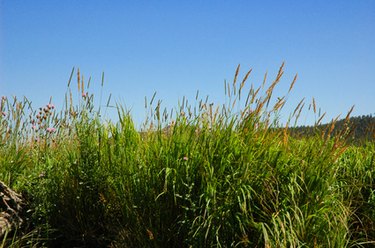Things You'll Need
Pick axe
Rototiller (optional)
Plastic bag
Compost
Rake
Grass seed or sod
Nitrogen
Lawn mower

Southern California's warm to hot climate with its mild winters offers the growing conditions ideal for warm-season grasses. Your options include, among others, Bermudagrass, which does well in the inland valleys, and buffalo grass, a good selection if your yard is in the state's southern desert. After you choose the grass to grow, preparing your soil is essential so that it can support your new lawn. Site preparation is the same for sod and seed.
Step 1
Break up the soil to a depth of 4 inches where the lawn is going to grow. For a small plot, use a pick axe. If you have a large area, or want the job to go faster, rent a rototiller at a tool shop.
Video of the Day
Step 2
Haul away weeds, roots, rocks and other debris that surfaces. This prevents competing vegetation from sprouting along with your lawn and robbing the grass of nutrients, water and space.
Step 3
Contact your local office of the California Cooperative Extension Service to find out how to go about getting your soil tested. The office either will perform the test or it will give you a list of labs that will.
Step 4
Collect a soil sample in a plastic bag and submit it to the lab for testing. The test result will include recommendations for amending your soil, listing specific nutrients and how much of each your soil needs.
Step 5
Incorporate nutrients into the topsoil. Apply the amendments that came as a recommendation with your soil test result. In addition, add about 4 inches of compost or manure to the ground. The organic matter improves air circulation and drainage.
Step 6
Rake the soil surface to smooth it out.
Step 7
Plant grass by broadcasting seeds with a spreader or by laying out the sod.
Step 8
Irrigate the seedbed as many as three times a day to keep it moist until the seeds germinate or the sod starts growing. In about 10 days, reduce the water gradually until you only irrigate the grass a couple times a week.
Step 9
Feed your Southern California lawn in spring, summer and early fall. Apply a maximum of 1 pound of nitrogen per 1,000 square feet each time you fertilize the grass. Feed it twice in spring or summer to bring the total nitrogen applied annually to 4 pounds.
Step 10
Mow your lawn as part of its regular maintenance. Cut one-third or less of the total length of the grass blades. Leave the clippings behind, but spread them over the lawn with a rake so their clumps don't block sunlight and water. As the clippings decompose, they provide the soil nitrogen.
Step 11
Cultivate your lawn to reduce disease. Pull weeds; aerate to maintain good water and air circulation; and remove thick layers of thatch that harbor pests.
Tip
Warm-season grasses are 20 percent more drought-tolerant than cool-season grasses, according to the University of California. The school also recommends watering in the morning when less moisture is lost to evaporation. By evening, the grass is also dry, reducing the risk of disease. See Resources for a link to an irrigation schedule for warm-season lawns in California.
Warning
Lawns in California are susceptible to several fungal infections, such as fusarium blight and pythium blight. Keeping your lawn well nourished, trimmed and adequately irrigated is the best way to prevent problems. But if infestations become severe, contact your local extension office for help identifying and treating the issue.
Video of the Day